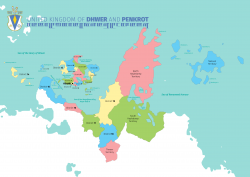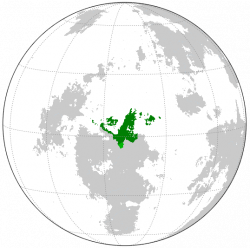Dhwer and Penkrot
| United Kingdom of Dhwer and Penkrot Nərətnar Yələnəran Ðweruw ər Penkerə̄tuw |
||||||
|---|---|---|---|---|---|---|
|
||||||
| Motto: The Noble and the Common | ||||||
Map of Dhwer
|
||||||
Location of the UKDP within Sahar
|
||||||
| Largest | KeHarl | |||||
| Official languages | Dhwer | |||||
| Government | ||||||
| - | Supreme Leader of the Kuulist Party and King of Dhwer and Penkrot | Haym-Kalb II | ||||
| Legislature | KaLenth | |||||
| Area | ||||||
| - | 1,450,400 km2 560,003 sq mi |
|||||
| Population | ||||||
| - | 2016 census | 110,422,300 | ||||
| - | Density | 76.1/km2 197.1/sq mi |
||||
| GDP (nominal) | estimate | |||||
| - | Total | 2,774,470,709,800 | ||||
| - | Per capita | 25,126 | ||||
| HDI (2015) | 0.5 low |
|||||
| Currency | Dhweran Yekt (DYT) | |||||
| Time zone | Central Boroso Time (SCT-3) | |||||
| - | Summer (DST) | not observed (SCT) | ||||
| Drives on the | right | |||||
| Calling code | +31 | |||||
| Internet TLD | .dh | |||||
Dhwer (Dhwer: Ðweruw [ˈðʷeʁuw]), officially the United Kingdom of Dhwer and Penkrot (Dhwer: Nərətnar Yələnəran Ðweruw ər Penkerə̄tuw [nəʁətˈnɑʁ jələˈnəʁɑn ˈðʷeʁuw əʁ ˈpeŋkeʁʌtuw]), abbreviated as the UKDP, is a country located in north-central Boroso.
The UKDP is comprised of two main parts, the island of Dhwer, and mainland Penkrot, separated by the Haym-Kalb II Sea.
Penkrot is bordered on the southeast by Taanttu and to the south and west by Lhavres. It shares a maritime border to the northwest with Mbamigi.
Etymology
History
Imperial Period
Between c. 500 CE and 1215 CE the Great Dhwerian Empire ruled much of Northern and Central Upper Boroso. In 1215 CE the empire collapsed into several 'shogunates' only nominally part of the same polity, as a culmination of a process of decentralization that had been happening since the eleventh century.
Fragmented Period
Setyal Period
Modern History
Dhwer would only become a de-facto centralized state in the early 1800s as a response from the military threat from the Setyal Empire. Through the late 1800s it would consolidate as an absolutist monarchy with strong ties to Kuyanist religious institutions. This consolidation of power was not without resistance; During the last two decades of the 1800s and the early 1900s several popular political movements grew in Dhweran society; from hardline Abolitionists to many movements on the Balko-Kuulist spectrum. The most important of which was the Kuulist Party of Dhwer. The Kuulist Party would be legalized in 1926 and steadily grow to be a branch of the government, especially as the persecution on abolitionist movements grew in the 40s.
In 1957 a Kuulist 'pseudo-coup' happened, in similar molds to the 1932 Mwamban revolution, as Emperor XX, who had come under scrutiny from groups inside the Dhweran political establishment for his poor handling of diplomatic missions to Ekuosia in the aftermath of the GEW, was deposed by his nephew, Haym-Baqr, a member of the Kuulist Party, that officially abolished the office of King and established the Dhweran Kuulist Republic, forming close diplomatic ties with Rosland, Helsonia and the Golden Kwang.
After the crystallization of a one party state that could be called totalitarian, civil and political liberties dropped even more, the abolitionist movement was suppressed as political parties were outlawed and persecuted and many political dissidents fled the country, most for Lhavres, Sangmia (some of which would participate in the failed Sangmian Balkist Revolution) or Magali. This soured the already shaky relations with Lhavres even more, especially as the volume of slave refugees increased, leading Lhavres to embargo Dhwer in 1962, economic and diplomatic sanctions between the two countries remain to this day, with several proxy conflicts in the disputed Thewer region happening since then. The Dhwer-Lhavres border becomes highly militarized in this period, as Lhavres slave freeing programs prompted the Dhweran goverment to increase oversight over the very extensive land border. Most of it is walled since the late 60s.
Dhwer was diplomatically isolated from northern Borosan countries after Mwamba aligned with Lhavres after 1963, and was increasingly alienated from global politics, especially after the Dhwer-Helsonia split in the 80s. After Haym-Baqr died of natural causes in 1984, the Kuulist KaLenth elected his son, Haym-Kalb I, as the next Supreme Leader of the Party. This prompted Vexut to denounce Dhwer's ways as "un-kuulist" citing the hereditary monarchical ways of the Kuulist Party of Dhwer and denouncing their continued practice of slavery. Other countries also denounced this succession. After Helsonia shifted it's focus to the Ekuosian Union in its liberalization efforts and broke diplomatic ties, Dhwer's economy felt into a recession, after a couple decades of stagnation, as they could no longer counter the Lhavresian bloc's embargoes and sanctions.
Dhwer kept ties with the Golden Kwang until the fall of the regime in 2005. After the fall of the Helsonian Union and the Golden Kwang in 2005, Haym-Kalb I officially adopted the title of Supreme Leader of the Kuulist Party and King of Dhwer and Penkrot and added hereditary succession to the Dhweran Constitution, along with mending the ties with the Kuyanic establishment, which was given less focus during the 1957-2005 period.
Haym-Kalb I died in 2014, being succeeded by his second son, Haym-Kalb II, in the office of Supreme Leader of the Kuulist Party and King of Dhwer and Penkrot.
Geography
Geology
Climate
Biodiversity
Politics
Government
Dhwer has a monarcho-kuulist government. While it is kuulist, it retained its royal family as the leadership of the Kuulist Party of Dhwer and Penkrot. It has been a one-party state since 1957. While it had officially renounced the monarchy and associated titles in 1957, the office of Supreme Leader remained hereditary and was declared a King title again in the 2005 constitutional adenda.
There is a legislative body, the KaLenth, constituted from the Kuulist party. Other political parties are outlawed.
Administrative divisions
Dhwer is divided into four main regions:
- Dhwer: The largest island, and most densely-populated populated region. Subdivided into 13 districts.
- Penkrot: The western half of the mainland. Subdivided into 6 district.
- Hayndwelp and Thyakw: The Eastern half of the mainland. Divided into 3 territories: North and South Hayndwelp and Thyakw.
- Thewer: A disputed territory with Lhavres which claims it as the state of Thewer.




